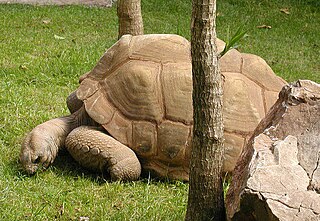
The Cryptodira are a suborder of Testudines that includes most living tortoises and turtles. Cryptodira differ from Pleurodira in that they lower their necks and pull the heads straight back into the shells, instead of folding their necks sideways along the body under the shells' marginals. They include among their species freshwater turtles, snapping turtles, tortoises, softshell turtles, and sea turtles.

Macrochelys is a genus of very large freshwater turtles in the family Chelydridae from Southeastern United States. Only a single extant species was recognized until a 2014 study divided it into two, or possibly three species.

Staurotypus is a genus of aquatic turtles, commonly known as giant musk turtles, Mexican musk turtles, or three-keeled musk turtles, in the family Kinosternidae. The genus contains two recognized species, which are endemic to Mexico and Central America. Both species are sold and bred as pets.
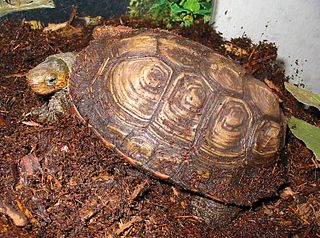
Rhinoclemmys is a genus of turtles in the family Geoemydidae, the only genus in the subfamily Rhinoclemmydinae. Member species of the genus are commonly known as the Neotropical wood turtles and are the only geoemydids known from the Americas. As such, they have adapted to a wide range of habitats, which is reflected in the species' common names.

Thalassemys is a genus of extinct thalassochelydian turtle from the Late Jurassic of western and central Europe. While the genus was originally named by Rütimeyer in 1859 for a large carapace and other associated fragments from the late Kimmeridgian of the Reuchenette Formation of Switzerland, although the taxon was not validly named until 1873 when Rütimeyer designated the type species T. hugii. Rütimeyer also named T. gresslyi from the Reunchenette Formation in the same paper as T. hugii, but it cannot be differentiated from the type material of T. hugii and is therefore a junior synonym. A large assemblage of shell and postcranial material from the Reunchenette was named as a species of Eurysternum, E. ignoratum, by Bräm in 1965. While originally distinguished based on the presence of fontanelles on the plastron, the feature was later identified on T. hugii and E. ignoratum was designated a junior synonym. Additional material from the Kimmeridge Clay of the United Kingdom has also been referred to T. hugii.
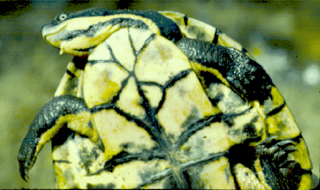
The Myuchelys is a genus of turtles, the Australian saw-shelled turtles, in the family Chelidae and subfamily Chelodininae. They inhabit the headwaters and tributaries of rivers within their range and this led to the name Myuchelys, which is formed from the Aboriginal word myuna meaning clear water and the Greek chelys meaning turtle. They have a short neck and the intergular scute completely separates the gular scutes. They have no alveolar ridge separating them from the snapping turtles of the genus Elseya.

Pleurosternon is an extinct genus of freshwater pleurosternid turtle from the late Jurassic period to the early Cretaceous period of Europe. Its type species, P. bullocki was described by the paleontologist Richard Owen in 1853. Since then, and throughout the late 19th century, many fossil turtles were incorrectly assigned to this genus, though only two are currently considered valid.
Hispaniachelys is an extinct genus of paracryptodire or basal testudines turtle known from the Lorente Formation of southern Spain. Reinterpretation of the original material shows that the taxon lacks diagnostic characteristics and is thus a nomen dubium.

Palaeomedusa testa is an extinct species of sea turtle from the Tithonian of the Late Jurassic. It was first described by the German palaeontologist Christian Erich Hermann von Meyer in 1860. It is the only species classified under the genus Palaeomedusa.
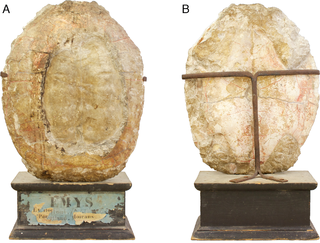
The Plesiochelyidae are an extinct family of turtles in the clade Thalassochelydia originally classified within the Cryptodira suborder, mostly belonging from the Jurassic period. An alternate study placed the clade Thalassochelydia in the Angolachelonia and outside the Testudines.
Achelonia is an extinct genus of thalassochelydian sea turtle. Its type species is Achelonia formosa. Fossils are known from the Upper Jurassic of Wattendorf, Germany, Cerin, France, and England. Material from England was originally considered to belong to the separate genus Enaliochelys and species Enaliochelys chelonia, named by Harry Govier Seeley in 1869 for a partial disarticulated skeleton from the early Kimmeridgian of the Kimmeridge Clay in Cambridgeshire. The synonymy was recognised in 2020.
Cyrtura is a dubious genus of extinct Testudinata from the Late Jurassic of the Solnhofen Formation of Bavaria, Germany. Cyrtura was originally described as a temnospondyl amphibian by Otto Jaekel in 1904 on the basis of MNB 1890, the distal portion of a tail with 14 caudal vertebrae. Most authors overlooked the genus, although those who mentioned Cyrtura dismissed it as either undiagnostic or referable to Testudines rather than Temnospondyli. Warren and Hutchinson (1983) rejected the temnospodyl classification of the genus based on examination of a cast of the holotype, and subsequent studies showed that Cyrtura is actually a marine turtle, although the lack of diagnostic characters renders it a nomen dubium.
Parachelys is a genus of late Jurassic turtle from marine deposits in Bavaria, southern Germany.
Hydropelta is a genus of late Jurassic turtle from marine deposits in the Jura Mountains of eastern France.
Chelonides is a genus of late Jurassic turtle from marine deposits in Lower Saxony, Germany.

Idiochelys is a genus of late Jurassic turtle from marine deposits in the Jura Mountains of eastern France and Bavaria, Germany.

Solnhofia is a genus of extinct thalassochelydian turtle from the Late Jurassic of Germany. The type species is Solnhofia parsoni, named by Gaffney in 1975 for a partial skull and jaw from the early Tithonian of the Solnhofen Formation in Bavaria. Additional material including a complete skeleton is known from the late Kimmeridgian of Switzerland and the Kimmeridgian/Tithonian of other deposits within Bavaria, and potentially also unprepared material from the Late Jurassic of France. The genus was referred to the family Eurysternidae by Anquetin and colleagues in 2017, which may represent an artificial clade of early thalassochelydians. In 2020 a new species Solnhofia brachyrhyncha was described from the Kimmeridigan aged Reuchenette Formation of Switzerland.
Aplax is a dubious genus of extinct thalassochelydian turtle from the Late Jurassic of Germany. The type and only species is Aplax oberndorferi, named by Hermann von Meyer in 1843 for a complete juvenile skeleton from the early Tithonian of the Solnhofen Formation in Bavaria. Despite being aware that shell morphology changes during growth, Meyer named Aplax due to his consideration it represented a relative of Dermochelys, where the adults lack distinction of shell regions as in Aplax. However the taxon was later referred to Thalassochelydia by Anquetin and colleagues in 2017, and due to the loss of the original holotype it cannot be identified as a distinct taxon of a juvenile of existing Solnhofen turtles and is therefore a nomen dubium.
Pelobatochelys is a genus of extinct thalassochelydian turtle from the Late Jurassic of the United Kingdom. The type and only species is Pelobatochelys blakii, named by Harry Govier Seeley in 1875 for a central carapace fragment along with five additional specimens from the remainder of the shell from the early Kimmeridgian of the Kimmeridge Clay in Dorset, and additional material from the Kimmeridge Clay has also been referred to the taxon. The material was considered to be related to various turtles throughout time, including being reassigned to Tropidemys as T. blakii based on limited evidence. A large shell also from Weymouth, Dorset may represent further material of Pelobatochelys, but could also be from Tropidemys langii which was also present in the deposits.
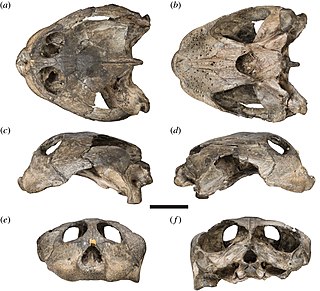
Sandownidae is a family of extinct marine turtles from the Cretaceous and Paleogene. The family is defined as all taxa closer to the type genus Sandownia than to Pelomedusa, Testudo, Solnhofia, Eurysternum, Plesiochelys, Thalassemys or Protostega, a definition that encompasses the previous concept of the clade while also excluding it from being synonymous with other clades of modern or extinct marine turtles. Sandownidae may be within the larger clade Angolachelonia, defined as inclusive of Angolachelys and Solnhofia, sister to the entirely Late Jurassic marine group Thalassochelydia, although the concepts of the clades may shift with further phylogenetic analysis.











